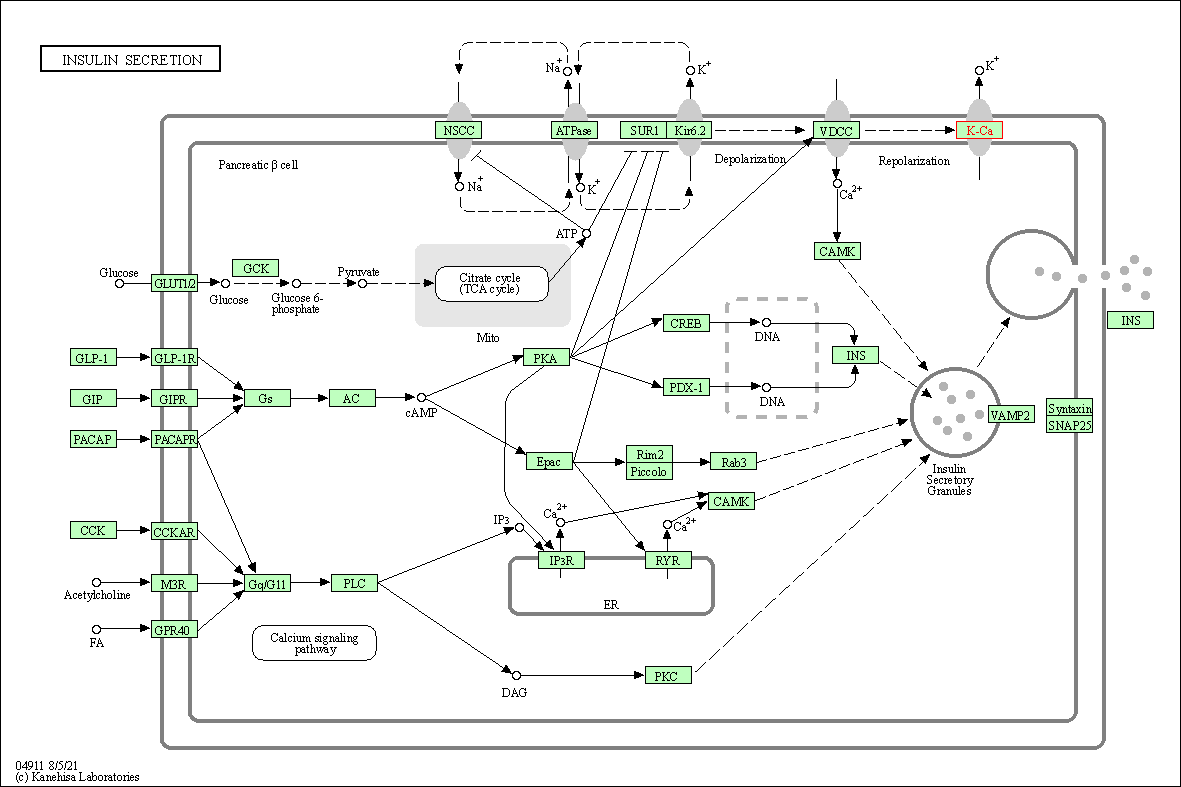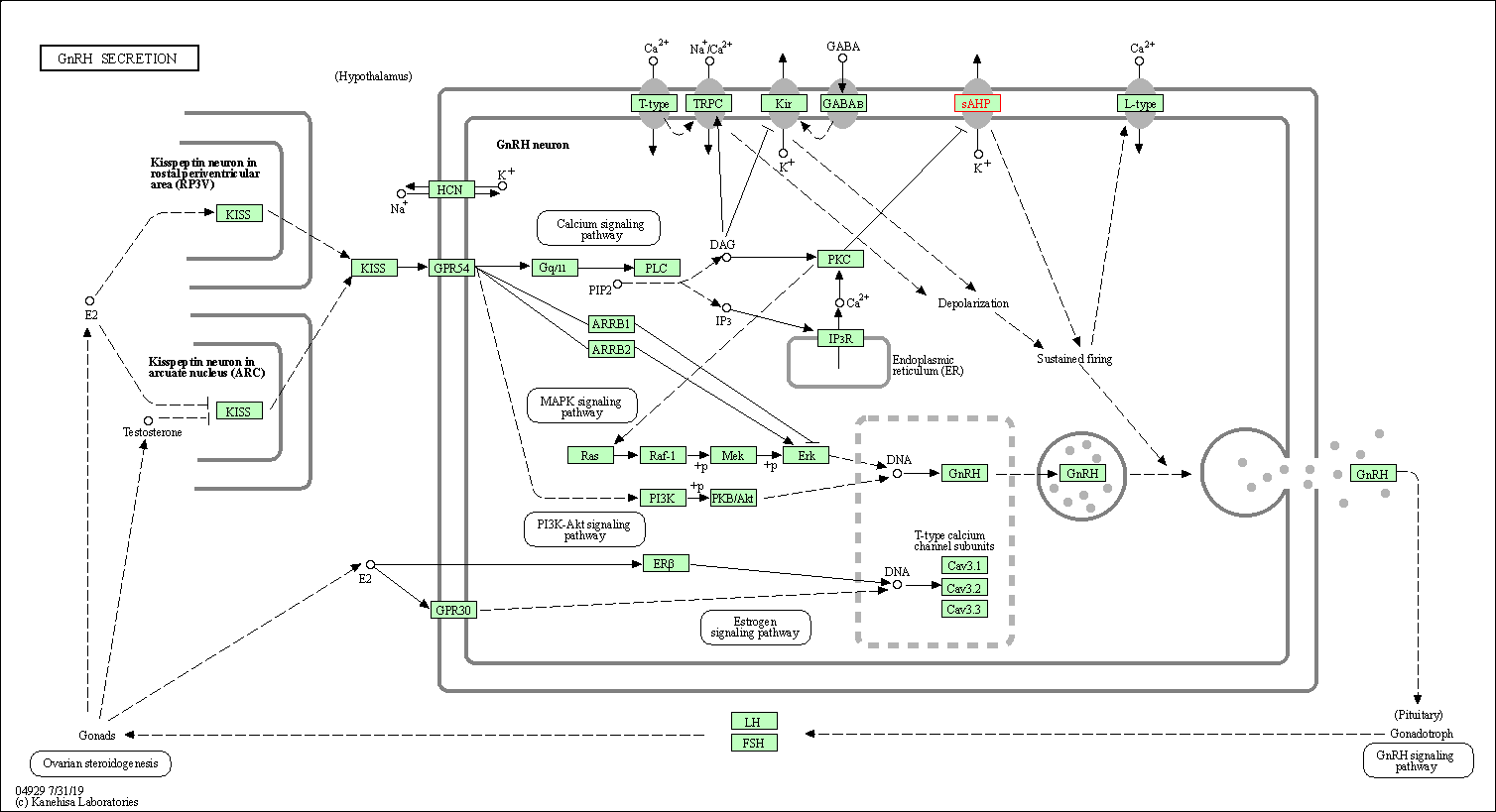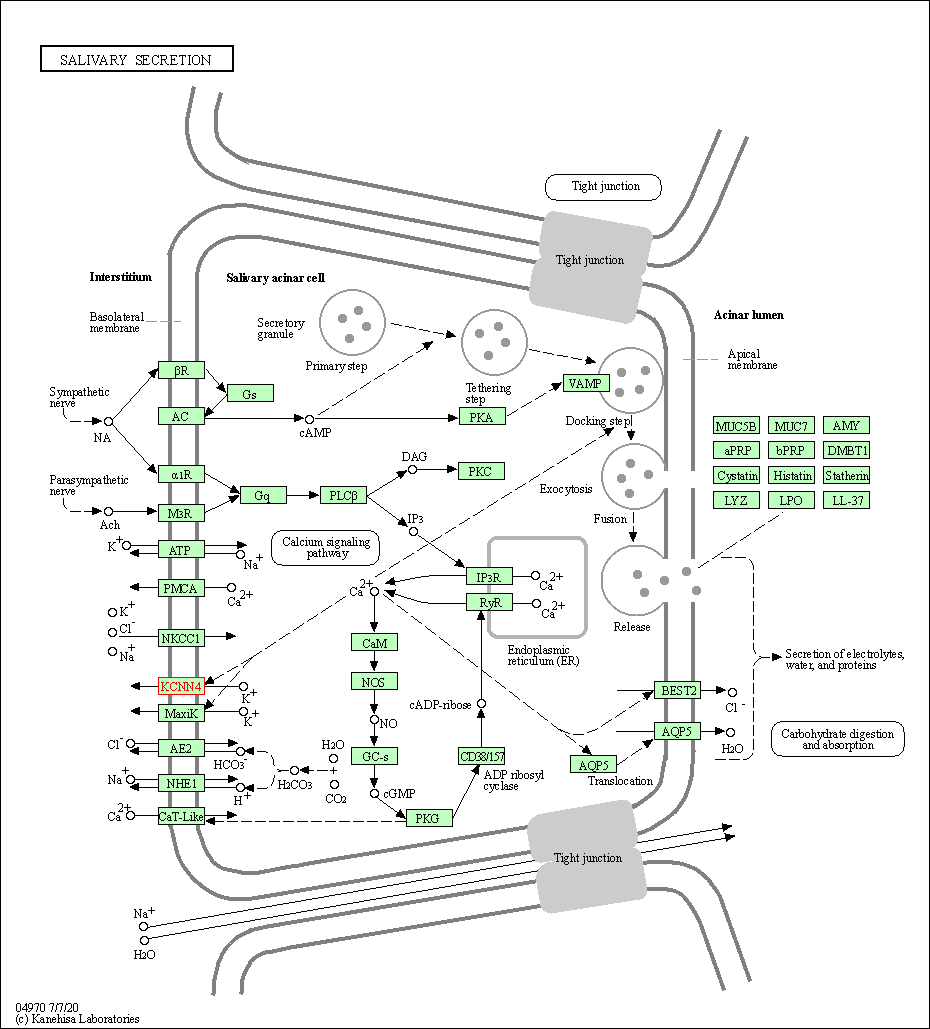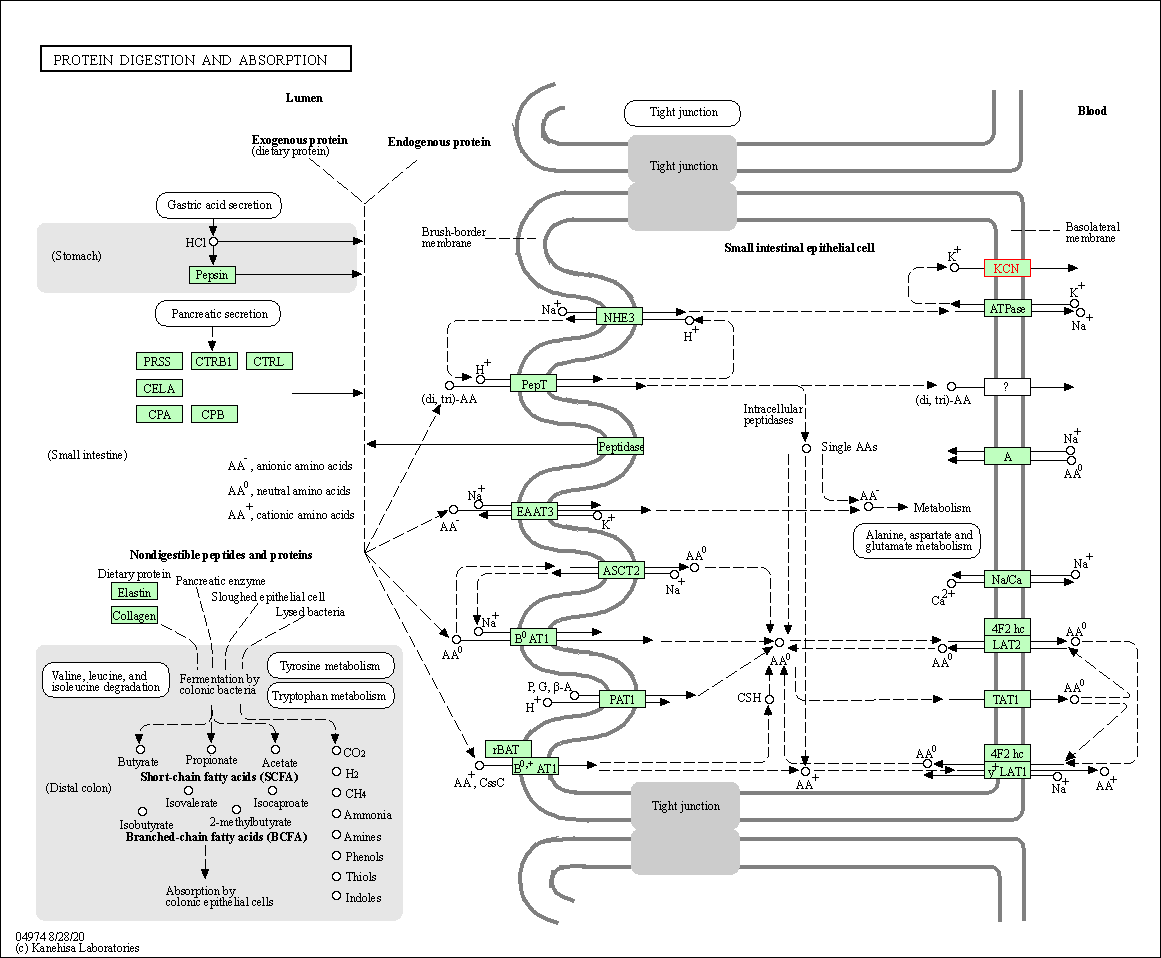Target Information
| Target General Information | Top | |||||
|---|---|---|---|---|---|---|
| Target ID |
T42724
(Former ID: TTDI03310)
|
|||||
| Target Name |
Calcium-activated potassium channel KCa3.1 (KCNN4)
|
|||||
| Synonyms |
SKCa4; SKCa 4; SK4; Putative Gardos channel; KCa4; KCa3.1; Intermediate conductance calcium-activated potassium channel protein 4; IKCa1; IK1
Click to Show/Hide
|
|||||
| Gene Name |
KCNN4
|
|||||
| Target Type |
Clinical trial target
|
[1] | ||||
| Disease | [+] 2 Target-related Diseases | + | ||||
| 1 | Alzheimer disease [ICD-11: 8A20] | |||||
| 2 | Chronic pain [ICD-11: MG30] | |||||
| Function |
Activation is followed by membrane hyperpolarization which promotes calcium influx. Required for maximal calcium influx and proliferation during the reactivation of naive T-cells. Plays a role in the late stages of EGF-induced macropinocytosis. Forms a voltage-independent potassium channel that is activated by intracellular calcium.
Click to Show/Hide
|
|||||
| BioChemical Class |
Voltage-gated ion channel
|
|||||
| UniProt ID | ||||||
| Sequence |
MGGDLVLGLGALRRRKRLLEQEKSLAGWALVLAGTGIGLMVLHAEMLWFGGCSWALYLFL
VKCTISISTFLLLCLIVAFHAKEVQLFMTDNGLRDWRVALTGRQAAQIVLELVVCGLHPA PVRGPPCVQDLGAPLTSPQPWPGFLGQGEALLSLAMLLRLYLVPRAVLLRSGVLLNASYR SIGALNQVRFRHWFVAKLYMNTHPGRLLLGLTLGLWLTTAWVLSVAERQAVNATGHLSDT LWLIPITFLTIGYGDVVPGTMWGKIVCLCTGVMGVCCTALLVAVVARKLEFNKAEKHVHN FMMDIQYTKEMKESAARVLQEAWMFYKHTRRKESHAARRHQRKLLAAINAFRQVRLKHRK LREQVNSMVDISKMHMILYDLQQNLSSSHRALEKQIDTLAGKLDALTELLSTALGPRQLP EPSQQSK Click to Show/Hide
|
|||||
| 3D Structure | Click to Show 3D Structure of This Target | PDB | ||||
| HIT2.0 ID | T54X6V | |||||
| Drugs and Modes of Action | Top | |||||
|---|---|---|---|---|---|---|
| Clinical Trial Drug(s) | [+] 2 Clinical Trial Drugs | + | ||||
| 1 | ASP0819 | Drug Info | Phase 2 | Fibromyalgia | [2], [3] | |
| 2 | ICA-17043 | Drug Info | Phase 2 | Alzheimer disease | [2] | |
| Mode of Action | [+] 3 Modes of Action | + | ||||
| Activator | [+] 5 Activator drugs | + | ||||
| 1 | ASP0819 | Drug Info | [4] | |||
| 2 | DC-EBIO | Drug Info | [6] | |||
| 3 | EBIO | Drug Info | [7] | |||
| 4 | SKA-121 | Drug Info | [9] | |||
| 5 | SKA-31 | Drug Info | [10] | |||
| Modulator | [+] 1 Modulator drugs | + | ||||
| 1 | ICA-17043 | Drug Info | [1] | |||
| Blocker (channel blocker) | [+] 2 Blocker (channel blocker) drugs | + | ||||
| 1 | 1-((2-chlorophenyl)diphenylmethyl)-1H-pyrazole | Drug Info | [5] | |||
| 2 | PMID15603962Crac-16 | Drug Info | [8] | |||
| Cell-based Target Expression Variations | Top | |||||
|---|---|---|---|---|---|---|
| Cell-based Target Expression Variations | ||||||
| Different Human System Profiles of Target | Top |
|---|---|
|
Human Similarity Proteins
of target is determined by comparing the sequence similarity of all human proteins with the target based on BLAST. The similarity proteins for a target are defined as the proteins with E-value < 0.005 and outside the protein families of the target.
A target that has fewer human similarity proteins outside its family is commonly regarded to possess a greater capacity to avoid undesired interactions and thus increase the possibility of finding successful drugs
(Brief Bioinform, 21: 649-662, 2020).
Human Pathway Affiliation
of target is determined by the life-essential pathways provided on KEGG database. The target-affiliated pathways were defined based on the following two criteria (a) the pathways of the studied target should be life-essential for both healthy individuals and patients, and (b) the studied target should occupy an upstream position in the pathways and therefore had the ability to regulate biological function.
Targets involved in a fewer pathways have greater likelihood to be successfully developed, while those associated with more human pathways increase the chance of undesirable interferences with other human processes
(Pharmacol Rev, 58: 259-279, 2006).
Biological Network Descriptors
of target is determined based on a human protein-protein interactions (PPI) network consisting of 9,309 proteins and 52,713 PPIs, which were with a high confidence score of ≥ 0.95 collected from STRING database.
The network properties of targets based on protein-protein interactions (PPIs) have been widely adopted for the assessment of target’s druggability. Proteins with high node degree tend to have a high impact on network function through multiple interactions, while proteins with high betweenness centrality are regarded to be central for communication in interaction networks and regulate the flow of signaling information
(Front Pharmacol, 9, 1245, 2018;
Curr Opin Struct Biol. 44:134-142, 2017).
Human Similarity Proteins
Human Pathway Affiliation
Biological Network Descriptors
|
|




| KEGG Pathway | Pathway ID | Affiliated Target | Pathway Map |
|---|---|---|---|
| Insulin secretion | hsa04911 | Affiliated Target |

|
| Class: Organismal Systems => Endocrine system | Pathway Hierarchy | ||
| GnRH secretion | hsa04929 | Affiliated Target |

|
| Class: Organismal Systems => Endocrine system | Pathway Hierarchy | ||
| Salivary secretion | hsa04970 | Affiliated Target |

|
| Class: Organismal Systems => Digestive system | Pathway Hierarchy | ||
| Protein digestion and absorption | hsa04974 | Affiliated Target |

|
| Class: Organismal Systems => Digestive system | Pathway Hierarchy | ||
| Degree | 1 | Degree centrality | 1.07E-04 | Betweenness centrality | 0.00E+00 |
|---|---|---|---|---|---|
| Closeness centrality | 1.12E-01 | Radiality | 1.00E+01 | Clustering coefficient | 0.00E+00 |
| Neighborhood connectivity | 5.00E+00 | Topological coefficient | 1.00E+00 | Eccentricity | 16 |
| Download | Click to Download the Full PPI Network of This Target | ||||
| Chemical Structure based Activity Landscape of Target | Top |
|---|---|
| Drug Property Profile of Target | Top | |
|---|---|---|
| (1) Molecular Weight (mw) based Drug Clustering | (2) Octanol/Water Partition Coefficient (xlogp) based Drug Clustering | |
|
|
||
| (3) Hydrogen Bond Donor Count (hbonddonor) based Drug Clustering | (4) Hydrogen Bond Acceptor Count (hbondacc) based Drug Clustering | |
|
|
||
| (5) Rotatable Bond Count (rotbonds) based Drug Clustering | (6) Topological Polar Surface Area (polararea) based Drug Clustering | |
|
|
||
| "RO5" indicates the cutoff set by lipinski's rule of five; "D123AB" colored in GREEN denotes the no violation of any cutoff in lipinski's rule of five; "D123AB" colored in PURPLE refers to the violation of only one cutoff in lipinski's rule of five; "D123AB" colored in BLACK represents the violation of more than one cutoffs in lipinski's rule of five | ||
| Co-Targets | Top | |||||
|---|---|---|---|---|---|---|
| Co-Targets | ||||||
| Target Regulators | Top | |||||
|---|---|---|---|---|---|---|
| Target-regulating microRNAs | ||||||
| References | Top | |||||
|---|---|---|---|---|---|---|
| REF 1 | Senicapoc (ICA-17043): a potential therapy for the prevention and treatment of hemolysis-associated complications in sickle cell anemia.Expert Opin Investig Drugs.2009 Feb;18(2):231-9. | |||||
| REF 2 | Antibodies and venom peptides: new modalities for ion channels. Nat Rev Drug Discov. 2019 May;18(5):339-357. | |||||
| REF 3 | Clinical pipeline report, company report or official report of the Pharmaceutical Research and Manufacturers of America (PhRMA) | |||||
| REF 4 | Efficacy and Safety of ASP0819 in Patients with Fibromyalgia: Results of a Proof-of-Concept, Randomized, Double-Blind, Placebo-Controlled Trial. J Pain Res. 2020 Dec 10;13:3355-3369. | |||||
| REF 5 | Blockade of the intermediate-conductance calcium-activated potassium channel as a new therapeutic strategy for restenosis. Circulation. 2003 Sep 2;108(9):1119-25. | |||||
| REF 6 | Benzimidazolone activators of chloride secretion: potential therapeutics for cystic fibrosis and chronic obstructive pulmonary disease. J Pharmacol Exp Ther. 2001 Feb;296(2):600-11. | |||||
| REF 7 | Small conductance calcium-activated potassium channels: from structure to function. Prog Neurobiol. 2010 Jul;91(3):242-55. | |||||
| REF 8 | IKCa-channel blockers. Part 2: discovery of cyclohexadienes. Bioorg Med Chem Lett. 2005 Jan 17;15(2):401-4. | |||||
| REF 9 | New positive Ca2+-activated K+ channel gating modulators with selectivity for KCa3.1. Mol Pharmacol. 2014 Sep;86(3):342-57. | |||||
| REF 10 | Naphtho[1,2-d]thiazol-2-ylamine (SKA-31), a new activator of KCa2 and KCa3.1 potassium channels, potentiates the endothelium-derived hyperpolarizing factor response and lowers blood pressure. Mol Pharmacol. 2009 Feb;75(2):281-95. | |||||
If You Find Any Error in Data or Bug in Web Service, Please Kindly Report It to Dr. Zhou and Dr. Zhang.

